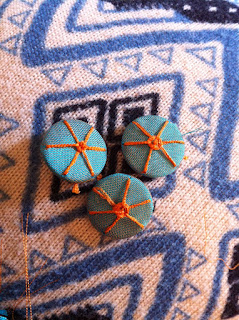Silk day dresses: Self-fabric, contrasting or coordinating fabric, velvet, glass, china, composite, gold and silver gilt, crochet, needlework, dorset, enameled, embroidered, and rosette.
Wool or cotton day dresses: Self-fabric, velvet, glass, china, vegetable ivory, gold gilt, mother of pearl, pearl, needlework
Sheer dresses: Glass, china, mother of pearl, crochet
Living historians as a whole, including myself, tend to go towards fabric covered buttons. They're easy to make, and there is no supply and demand to worry about. But look at all the other options we're missing! Here are some of my favorite buttons on period dresses:
And I think my favorites have to be the snake buttons from this 1857 wedding dress:
A popular choice for silk dresses and wrappers were rosette buttons. Plenty of living historians have embraced the rosette belt concept. Directions can be found at The Sewing Academy.
Aside from rosettes for belts, there are lots of examples of women using rosettes as buttons or as trim on sleeves and skirts. Here are a few:
With my latest dress, I found this inspiration:
Thread buttons with a rosette. So pretty! Now, for buttons like the original, you would need buttons with a single middle hole then wrap thread around them in stripes. You could also use dorset buttons and wrap thread around them. I used thread covered and did some embroidery around them. I tried doing bullion knot like flowers as in this period button:
Well, it turns out my bullions are not quite up to par. So I ended up doing a 6-pointed star of sorts with a twisted silk cord and then wound thread around the middles of the stars like a spider web (I always called it the spider stitch-not sure what the official name is). It turned out something like this:
You start off with a plain button and a circle of fabric that's bigger than the button. I can't really explain how much bigger because it depends on the size of your button, but enough to cover the outside then enough to meet in the middle when folded down. I'm not good at cutting circles so I did the best I could.
Then, I took my silk (since I had a shot silk and wanted to use the secondary color for the design) and fringed it, taking 6 strands of silk.
I used these as embroidery floss and made a French knot in the middle of the fabric circle. Then I sewed basting stitches around the circumference of the circle. I put the button in the middle of the circle and pulled on the basting stitches. Then all you have to do is secure it and you have a covered button (with a knot in the middle).
This is what I used to make the 'star' of sorts. When I had made the star, I began weaving the thread on top of one star point then under the next one to make a spider web effect. I went around the star about 3-4 times before I secured the thread behind the button. Voila!
Next, I took a 6" piece of fabric 2.5" inches long (my buttons were around 1/2" in diameter). I folded this piece in half length wise and sewed the two ends together so that they were invisible.
I made basting stitches around the raw edge. Then I pulled them up so they were a little circle. I used an invisible stitch to attach this to the button:
And there you have it! A rosette button for your gown or wrapper!
Photos of the blue/gold gown to come!










































No comments:
Post a Comment